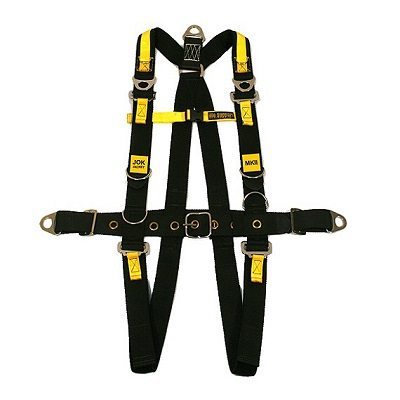
The JOK II is a CE-marked Diver recovery harness to permit recovery of a fully-kitted diver from the water in air diving or bell diving conditions.
Lifting can be via a rear of neck ‘D’ Ring or with a spreader bar across the two front of harness lifting points. The under-leg straps are essential for diver recovery.
It is important to differentiate between certified lifting points and lightweight tool attachment points. The special profile-cut ‘D’ rings make no doubt which to use, and assist the diver in poor visibility or stressed conditions.
Testing
Very few diver recovery harnesses have ever been tested to ensure that they actually support the diver when he needs it. C-Tecnics have developed a rigorous test protocol and procedure when designing the Mk1 harness and continue this striving for the best with the MKII.
The JOK II harness was tested at 900Kg/N with no failure of stitching or webbing. The special profile cut ‘D’ rings were selected to overcome any doubts which may occur when using normal welded ‘D’ rings for lifting purposes as we uncovered that the manufacturers of these traditional items would not load certify them as they could not guarantee the weld quality.
As no CE standard existed for diver recovery harnesses LSE adopted a pragmatic approach to the creation of such a standard.
Dynamic loading was potentially an issue if a diver were to fall when being recovered, or exiting, from the water or indeed if the diver was to be effected by swell or waves at the point of surface recovery. The routing of the webbing had to be changed from some of the early design of one piece ‘wrap round’ webbing as it simply wouldn’t take the strain in testing – we have proven that many other designs are simply inadequate…
The weight of a fully kitted diver was estimated as 150kg allowing for suit, bail-out and other equipment. A 6:1 safety factor was then used to provide the load testing requirement – similar to other safety-critical harnesses.
Maintenance & Testing
As per other lifting equipment, it is strongly recommended that the diver’s recovery harness is added to the company’s Planned Maintenance System (PMS).
The harness should be inspected by a ‘competent person’ every 6 months for any sign of abrasion or stitching failure, along with other damage to component parts etc.
Consideration should be given to adopting IMCA’s policy on such life support equipment to ensure is continues being fit for purpose. Refer to IMCA document DESIGN D018 detail sheet 34.
Contact us today for information about new Commercial Diving Equipment, Used Commercial Diving Equipment and/or Kirby Morgan Helmets!
Interested in this product? Contact Us
